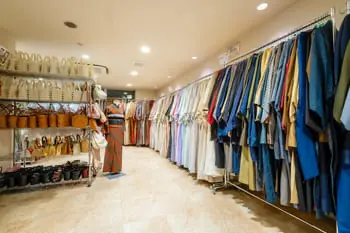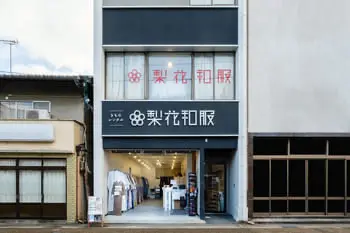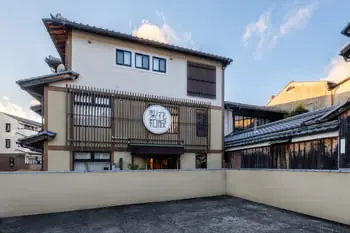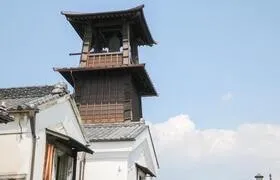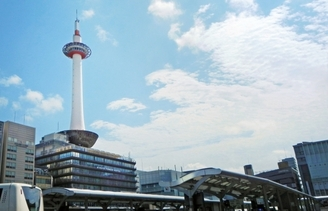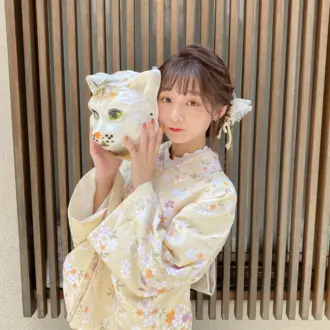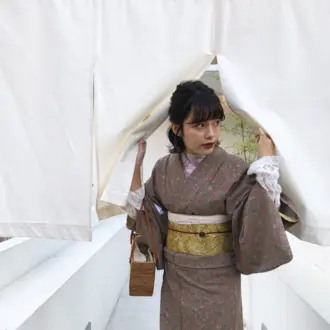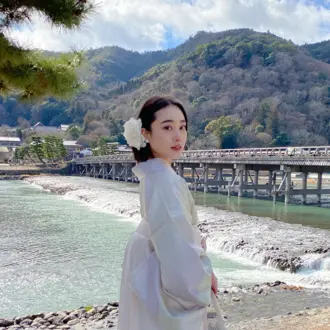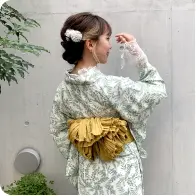How to walk without ruining your kimono when renting it in Kyoto
When you visit Kyoto, you might want to stroll through the city in a kimono that suits Kyoto’s scenery.
However, for those who are not used to wearing kimonos regularly, even with proper dressing assistance, kimono may get disheveled while taking the train.
Once the kimono gets disheveled, it’s challenging to fix it by yourself. So, let’s explore some tips to prevent it from happening.
Tips to Avoid Kimono Dishevelment While Taking the Train
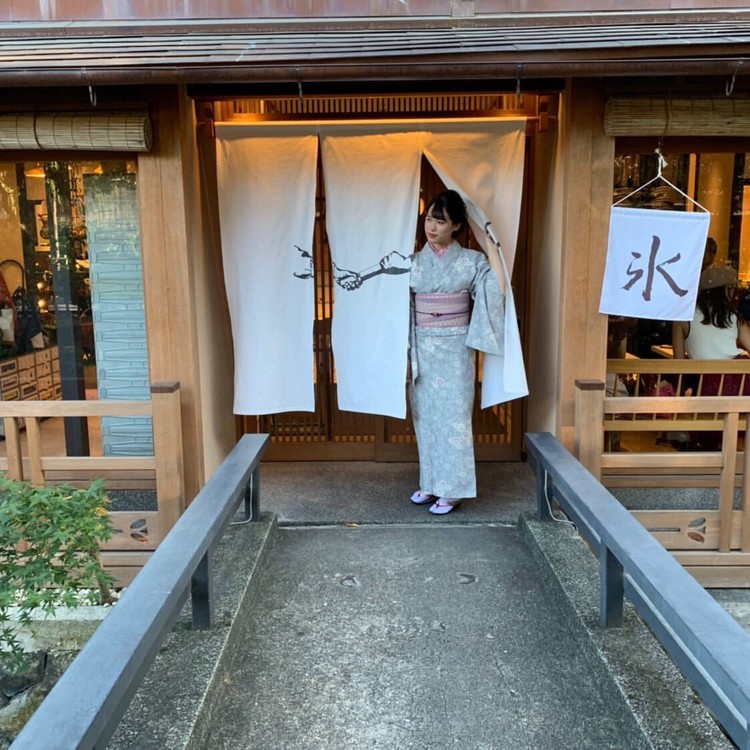
Many people use trains and buses for sightseeing during their trips to Kyoto, considering the convenience of transportation.
However, kimono is prone to getting disheveled while traveling on trains because you often need to stand or sit.
Therefore, it’s essential to know how to prevent your kimono from getting disheveled during train rides.
Start with Walking in a Kimono Without Dishevelment
Walking in a kimono is slightly different from your regular walking style.
Since you’ll likely be walking a lot while taking the train, pay attention to your walking style in a kimono. If you’re interested in how to walk in a kimono without dishevelment, you can check it out here.
Avoid Leaning on Train Seats
When taking the train, most people tend to lean back against the seat for comfort.
However, kimono has an obi (sash) that can easily get pushed out of place when leaning against the seat, causing dishevelment.
When sitting in a seat, try to sit shallowly and keep your back straight to avoid leaning against the backrest.
Additionally, when sitting in a seat, lifting the area around your thighs slightly before sitting down can help prevent disarray of your kimono.
When Standing, Face Away from Doors and Walls
When boarding a train, some people prefer to stand instead of sitting. When standing on a train, it’s essential to avoid facing your back towards others.
Turning your back towards others can increase the risk of someone unintentionally grabbing your kimono if the train suddenly jolts or your posture is disrupted. By facing away, you reduce the likelihood of kimono disarray.
Furthermore, when standing on the train, be mindful not to lean against the doors or walls. Try to stand about a step away from them.
Keep Your Elbows Down While Holding onto Straps
Trains can sometimes experience turbulence, leading passengers to hold onto straps for support. When wearing a kimono and holding onto straps, it’s essential to keep your elbows from sticking out.
In Kyoto, where kimono sightings are more common than in other regions, it’s understandable that elbows might occasionally be visible. Therefore, when grabbing a strap, use your other hand to hold onto your kimono’s sleeve, ensuring that your elbows remain inconspicuous.
Recommended Train Travel Routes
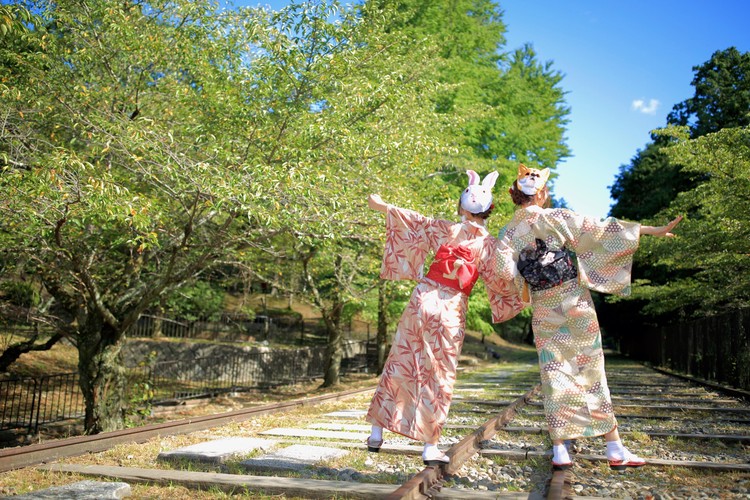
When visiting Kyoto for sightseeing and wearing a kimono, it’s recommended to plan your routes to get off as close to your destination as possible when using trains and buses.
Kimono wearers, especially those unaccustomed to wearing them, tend to be more conscious of their attire. Since geta (wooden clogs) and zori (straw sandals) can be less comfortable to walk in, it’s a good idea to minimize the need for walking long distances.
By learning how to prevent kimono disarray, you can make train travel less cumbersome. Kyoto offers excellent public transportation options, making it convenient to explore the city in a kimono.
Recommended Train Travel Routes
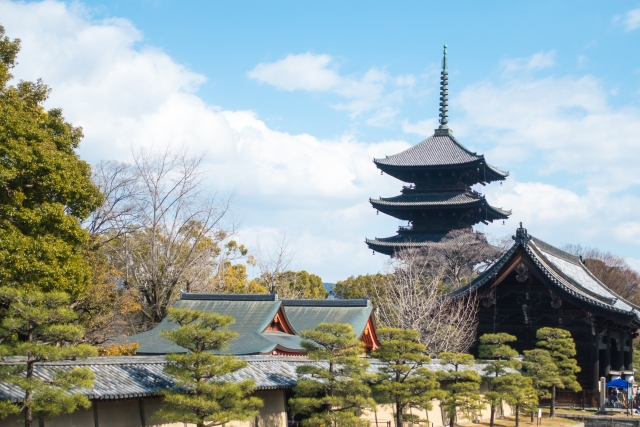
Many shops offer kimono rentals in Kyoto, and some even provide same-day rental services.
In Kyoto, there are various locations where you can rent kimonos, but one of the most popular areas is undoubtedly Gion.
If you choose to rent a kimono in Gion, it’s recommended to explore the Gion district first and then visit places like Arashiyama, Fushimi Inari, Kifune Shrine, and Nando-ji.
Gion is easily accessible by train, with nearby stations including Hankyu Kawaramachi Station, Keihan Gion-Shijo Station, and Subway Sanjo Station.
Moreover, the areas around these stations are home to many famous tourist spots, making it an ideal choice for those who wish to explore after renting kimonos in Gion.
Recommended Train Routes for Different Train Lines
- Popular Tourist Destinations Accessible by Train
- Arashiyama Area: Matsuo Shrine
- Gion Area: Fushimi Inari, Shosei-in, Uji Byodo-in, Nanzen-ji
If you’re looking for tourist spots accessible by train, consider visiting places like Arashiyama, Matsuo Shrine, and Kinkaku-ji.
If you plan to use the Keihan Electric Railway, exploring Fushimi Inari, Kifune Shrine, Shosei-in, and Uji Byodo-in is a great option.
For those opting for the Kyoto Municipal Subway to explore tourist spots, consider visiting Nando-ji, Kyoto Botanical Garden, Heian Shrine, Kyoto Municipal Zoo, Kamigamo Shrine, and Nijo Castle.
After exploring Nando-ji, it’s also recommended to visit Yasaka Shrine, Kiyomizu Temple, and Fushimi Inari, where you’ll find plenty of shops lining the slopes leading to Kiyomizu Temple, making it enjoyable to search for souvenirs or dine.
If you can fully enjoy your Kyoto trip in one go, it’s guaranteed to become a travel destination you’ll want to revisit.
Is the “Kimono Police” in Kyoto Just Envy?
Known for its nickname as the “most ill-tempered prefecture” in Japan,
While exploring Kyoto in kimonos, you may encounter the rare breed known as the “Kimono Police.”
Of course, they’re not real police but rather individuals who can’t help but criticize others’ kimono attire, which can be quite annoying.
These kimono enthusiasts in Kyoto, mostly older women, have an elevated sense of pride and can make various comments like “That tourist’s kimono attire is inappropriate” or “Such kimono attire is unbecoming.”
Frankly, it’s just envy on their part.
When traveling on trains, you’ll often find tourists and locals mingling, so it’s important to be cautious!
★Helpful tips and guides for your kimono rental experience
Kimono Rental in Kyoto & Asakusa: 5 Common Mistakes to Avoid on the Same Day
Where is the best reservation area for kimono rental in Kyoto?
★Explore more articles recommended for your trip to Kyoto.
Kyoto Kimono Rental for Couples – Explore the City in Traditional Style!
We recommend renting a kimono in Kyoto and traveling alone! Make wonderful memories!
10 sightseeing spots where you should rent a kimono during New Year’s in Kyoto
Author of this article
Kyoto Kimono Rental Rika Wafuku operates four kimono rental shops in Kyoto city, including locations in Arashiyama, Gion, Kiyomizu Temple, and in front of Kyoto Station. In 2023, they served over 230,000 customers in the Kyoto area!
They offer affordable plans, with a kimono dressing plan starting from 3,500 yen, and a hair setting plan from 5,500 yen.
Close to popular tourist spots such as Togetsukyo Bridge, Kiyomizu Temple, Yasaka Koshindo, and Yasaka Shrine!
Kimono Rental RikaWafuku in Kyoto
Kimono Rental Rika Wafuku Gion Store
Kimono Rental Rika Wafuku Arashiyama Store
Kimono Rental Rika Wafuku Kiyomizu Temple Store
Kimono Rental Rika Wafuku Kyoto Station Front Store
Check the Rikawafuku Rental!

